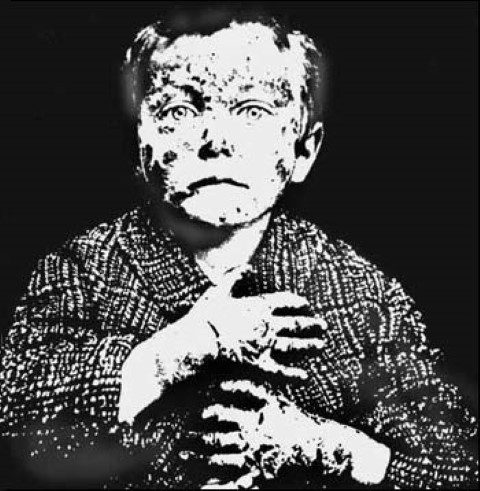Adil Menon
Chicago, Illinois, United States
 |
| A young boy with Pellagra Courtesy of the National Library of Medicine; Man, reproduced with permission of the Waring Historical Library of the Medical University of South Carolina, Charleston, SC. |
If a hero is defined as “someone who has given his or her life to something bigger than himself or herself,” Joseph Goldberger has more right to the title than most. In the face of tremendous odds and entrenched prejudice, he offered his great medical skills and work ethic and even put his own body at risk in order to rid his adoptive nation of a terrible malady.
Joseph Goldberger was born July 16, 1874 to sheep herders near Girált in the former Austro-Hungarian Empire. Abandoning their homeland after disease ravaged their flocks, the Goldbergers immigrated to America in search of opportunity, eventually finding it in the form of a small grocery business on New York’s lower east side. Growing up here surrounded by his siblings (five older, three younger), young Joseph aspired to a career in engineering, but a lecture by Dr. Austin Flint Jr. at Bellevue Hospital in 1892 inspired him to devote himself to the study of the human body. But his true calling did not revealed itself until 1899, when bored with private practice the young physician assumed the post of assistant surgeon for the United States Marine Hospital Service (later the U.S. Public Health Service or PHS).
Dr. Goldberger soon proved himself a devoted and skilled epidemiologist. From 1902-1906 he waged a multi-pronged campaign against yellow fever, fighting the scourge in Mexico, Puerto Rico, Mississippi, and Louisiana. It was also during this period that the son of poor Jewish immigrants married Mary Farrar, scion to a wealthy southern family and grandniece of Jefferson Davis. His newly married state did little to hinder Dr. Goldberger’s work. He soon journeyed to Texas after an outbreak to dengue fever and then returned to Mexico to combat typhus. While all these efforts earned Goldberger a much-deserved reputation, it was in 1914 while battling diphtheria in Detroit that he received the order to begin investigating pellagra, the disease that would make his career.
Arriving in the Deep South Dr. Goldberger found himself facing not only a formidable disease that killed 40% of those it infected, but also a society and a medical establishment eager to see him fail. As a foreign born, northern educated Jewish professional in the Jim Crowe South, Goldberger served as a walking reminder to the community of all they hated. Compounding his difficult situation was the fact that while the existence of a “pellagra germ” was considered gospel among southern medical professionals, to Goldberger’s experienced eye pellagra was undoubtedly a deficiency disease. This interpretation implied that the poverty of Southern sharecroppers, tenant farmers, and mill workers was not only morally wrong but also had health consequences. In the face of such entrenched antagonism, drastic measures were necessary if Goldberger were to demonstrate the validity of his theories. The first of these emerged from the depths of disaster. As boll weevils destroyed cotton crops across the south, farmers were forced to grow additional food crops, inadvertently improving their diet and lowering rates of pellagra. On top of this blessing in disguise, Goldberger ran scientific trials using prisoners as subjects. In these studies he clearly demonstrated the benefit of a diet of fresh meat, milk, and vegetables over a corn-based diet, both in recovering from pellagra and preventing it. Despite strong evidence for Goldberger’s assertions, his rivals remained unconvinced. In order to sway the recalcitrant individuals, Goldberger put his own body on the line. In what came to be called “filth parties” Dr. Goldberger, his wife (at her own request), and his assistants injected themselves with the blood of pellagra sufferers, swallowed extracts from pellagra sores, and exposed themselves to various other bodily secretions from the afflicted. No one exposed in this manner developed pellagra, thus rendering the germ theory untenable. Having proved his point, Goldberger dedicated the rest of his life to determining “the preventative factor” that would allow him to deal the disease a final defeat.
Joseph Goldberger’s efforts earned him five Nobel Prize nominations. He died in 1929. Sadly, he became a victim of his own extraordinary success. With Conrad Elvehjem’s 1937 discovery that the disorder was caused by niacin deficiency and thus could be treated, pellagra, a disease that killed four out of ten who contracted it, faded from the public mind along with its conqueror. Though society at large may have forgotten Dr. Goldberger, the medical community never did. Today his portrait hangs in the National Institutes of Health, and his extraordinary crusade inspires public health advocates the world over.
References
- “Dr. Joseph Goldberger and the War on Pellagra, by Alan Kraut, Ph.D.” Dr. Joseph Goldberger and the War on Pellagra, By Alan Kraut, Ph.D. National Institutes of Health, n.d. Web. 30 Nov. 2013.
- “Eskind Biomedical Library.” Eskind Biomedical Library. N.p., n.d. Web. 30 Nov. 2013.
- PBS. PBS, n.d. Web. 30 Nov. 2013.
ADIL MENON is currently a second-year student at the University of Chicago from Cleveland, Ohio. He is majoring in the History, Philosophy, and Social Science of Science and Medicine (HIPS) with a concentration in bioethics, with hopes of matriculating to medical school. He currently serves as an editor for the Triple Helix undergraduate research journal, and mentors adolescents affected by sickle cell disease for the STRIVE program. The author also serves as GHU coordinator for Globemed at the University of Chicago.
Highlighted in Frontispiece Spring 2015 – Volume 7, Issue 2
Spring 2015 | Sections | Physicians of Note

Leave a Reply